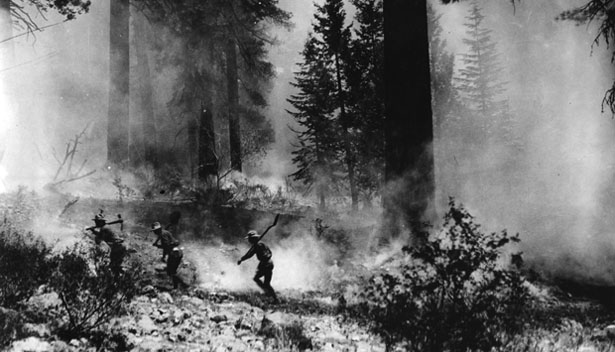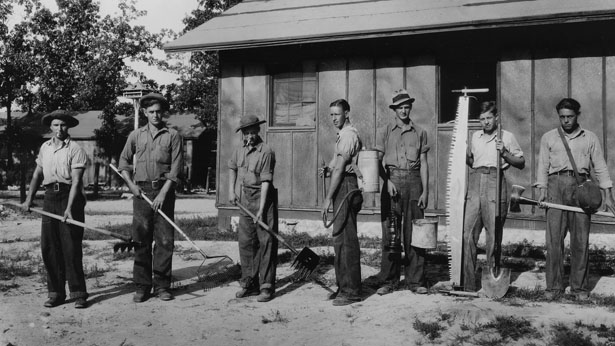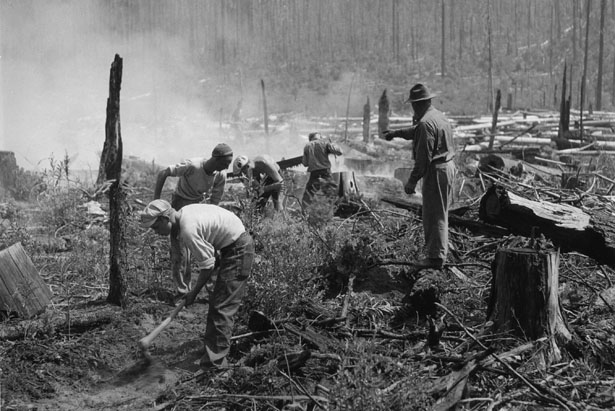U.S. Forest Service Fire Suppression

Fire fighters going to the front, Lassen National Forest, 1927.
Legendary forest fires in the late 1800s like the Peshtigo Fire of 1871 bolstered the argument by early conservationists like Franklin Hough and Bernhard Fernow that forest fires threatened future commercial timber supplies. Concern for protecting those supplies and also watersheds helped conservationists convince the U.S. government in 1891 to begin setting aside national forest reservations. When the U.S. Forest Service was established in 1905, it was given managerial control of these lands, soon renamed national forests. Forest management necessitated fire protection. After all, foresters argued, why create national forests if they were going to burn down.
Just five years later, in what has become known as the "Big Blowup," a series of forest fires burned 3 million acres in Montana, Idaho, and Washington in only two days. The 1910 fires had a profound effect on national fire policy. Local and national Forest Service administrators emerged from the incident convinced that the devastation could have been prevented if only they had had enough men and equipment on hand. They also convinced themselves, and members of Congress and the public, that only total fire suppression could prevent such an event from occurring again, and that the Forest Service was the only outfit capable of carrying out that mission. Three of the men who had fought the 1910 fires—William Greeley, Robert Stuart, and Ferdinand Silcox—served from 1920 to 1938 as Forest Service chief, which put them in a position to institute a policy of total fire suppression.

Civilian Conservation Corps fire fighting crew, Clark National Forest, 1937.
This policy had two goals: preventing fires, and suppressing a fire as quickly as possible once one started. To prevent fires, the Forest Service came out in opposition to the practice of light burning, even though many ranchers, farmers, and timbermen favored because it improved land conditions. It must be remembered that at this time foresters had limited understanding of the ecological role of fire. Forest Service leaders simply argued that any and all fire in the woods was bad because it destroyed standing timber. Educating the public about the need for fire prevention became an important part of this goal. In 1944, the Forest Service introduced the character Smokey Bear to help deliver its fire prevention message.
The other goal the Forest Service had was to develop a systematic approach to fire protection. In the decades following the Big Blowup, this would involve building networks of roads, communications systems, lookout towers, and ranger stations. To protect both federal and non-federal lands, the agency won passage of the Weeks Act of 1911, which in part established a framework between the federal government and the states for cooperative firefighting (the framework would later include private forest associations and landowners). By offering financial incentives to states to fight fires, the Forest Service came to dominate and direct what amounted to a national fire policy.

Fire fighters building a fire line, Gifford Pinchot National Forest, 1934.
Following several severe fire seasons in the early 1930s, fire suppression took on even greater urgency. In 1933, the federal government created the Civilian Conservation Corps, which put thousands of men to work building fire breaks and fighting fires. In 1935, the Forest Service established the so-called 10 a.m. policy, which decreed that every fire should be suppressed by 10 a.m. the day following its initial report. Other federal land management agencies quickly followed suit and joined the campaign to eliminate fire from the landscape. Fire suppression efforts were aided by the development of new technologies, such as airplanes, smokejumpers, medicines, and fire suppression chemicals. With such tools, fires could be fought anywhere—and were.
Until around 1970, federal land managers remained obsessed with controlling large fires. But during the 1960s, scientific research increasingly demonstrated the positive role fire played in forest ecology. This led in the early 1970s to a radical change in Forest Service policy—to let fires burn when and where appropriate. It began with allowing natural-caused fires to burn in designated wilderness areas. From this the "let-burn" policy evolved, though it suffered a setback in the wake of the 1988 Yellowstone fires. Since around 1990, fire suppression efforts and policy have had to take into account exurban sprawl in what is called the wildland-urban interface. Another issue the Forest Service now faces is that fires have grown in size and ferocity over the last 25 years. The fire-fighting budget has grown to about 50 percent of the agency’s entire budget, which limits funds available for land management activities such as land restoration and forest thinning that could aid in fire suppression.
Additional Resources
- "The Relation of Forests and Forest Fires," by Gifford Pinchot, 1899, reprinted in Forest History Today, Spring 1999: 29-32. [PDF]
- "Fire Prevention and Control on the National Forests," by F. A. Silcox, 1910. [PDF]
- 1916 Forest Service fire suppression manual for District 5 (California), by Roy Headley. [PDF]
- "'Piute Forestry' or the Fallacy of Light Burning," by William B. Greeley, 1920, reprinted in Forest History Today, Spring 1999: 33-37. [PDF]
- "The Fire Suppression Policy of the U.S. Forest Service," by Earl Loveridge, 1944, reprint from Journal of Forestry [PDF]. The article contains a reprint of Chief Silcox's "10 a.m. policy" circular letter issued in May 1935.
- "The Forty-Man Crew: A Report on the Activities of the Experimental Fire Suppression Crew," by Edward P. Cliff and Rolfe E. Anderson, 1939. [PDF]
- "Forest Fire Control in the United States of America," by W. D. Muir, 1941. (digitization by the Forestry Corporation of New South Wales, Australia) [PDF]
- "Trial by Fire: Early Forest Service Rangers' Fire Stories," by Timothy Cochrane, from Forest & Conservation History, January 1991: 16-23. [PDF]
- "Flame & Fortune," by Stephen J. Pyne, Forest History Today, 1996: 8-10. [PDF]
- "The Wildland-Urban Interface Fire Problem," by Jack Cohen, Forest History Today, Fall 2008: 20-26. [PDF]
- "The History of Cooperative Forest Fire Control and the Weeks Act," by Lewis F. Southard, Forest History Today, Spring/Fall 2011: 17-20. [PDF]
Browse historic images from the following FHS online photo galleries:
- Fire Fighting Equipment
- Fire Suppression -- Aircraft
- Fire Suppression -- Hand Tools
- Fire Suppression -- Helicopter
- Fire Suppression -- Smokejumpers
- Fire Suppression -- Water
- Fire Weather -- Measurement

